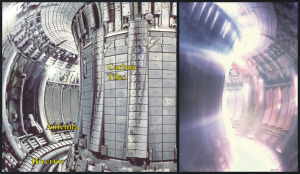

Plasma Physics and Controlled Fusion

Tokamaks are among the most promising devices for obtaining nuclear fusion energy from a high-temperature, ionized gas (plasma).
In tokamaks, there are two components of the confining magnetic field. A set of toroidal field coils, evenly spaced around the torus provides a strong toroidal magnetic field that is kept constant during the whole discharge and provides for plasma stability. The second component, the poloidal field, is responsible for the equilibrium of the plasma. It is produced by the plasma current and can be shaped by using the set of Poloidal Field Coils. The current is induced in the plasma by transformer action, where the primary is constituted by the full set of Central Solenoid and Poloidal Field Coils and the secondary is the plasma ring.
The activity of the group concerns several aspects ranging from the problem of controlling the current, shape and position of the plasma inside the chamber, to the development of algorithms for the real time reconstruction of the plasma boundary, to the study of the solution of the equilibrium Grad-Shafranov equation.
|
RESEARCH AREAS |
|
Grad-Shafranov equation Plasmas are conductive fluids and the relevant phenomena are governed by the laws of MagnetoHydroDynamics that combine Maxwell’s laws with fluid equations. For magnetically confined plasmas in spherical or toroidal configurations the equilibrium between the kinetic pressure and the magnetic pressure is regulated by the Grad-Shafranov equation, that is a nonlinear elliptic equation: solving the equilibrium means finding the general solution to the 2D G-S equation for given profile functions and boundary conditions. |
|
|
Open-loop non-linear Simulations with MAXFEA code In modern tokamaks vertically elongated plasma cross sections are employed to reach better performances. Such configurations have the drawback of being unstable, requiring therefore an active feedback control system to keep the plasma in equilibrium. Plasma movements are stabilized on the fast time scale by the image currents induced in the passive structures. At this regime no active control seems feasible since the instability growth time is of the order of few micro seconds. On a longer time scale the plasma is still unstable since, as the induced currents decay, the plasma drifts from the original position. However, on such a slower time scale, tipically of the order of hundreds of milli seconds, active control is possible. Open loop analysis are needed to optimize the stabilizing effect of the conducting structures surrounding the plasma and to examine the stability parameters of the configuration. The analysis are computed by the MAXFEA code written by P. Barabaschi. The code solves for the free boundary Grad-Shafranov problem, a two dimensional formulation of the ideal Magneto Hydro Dinamics (MHD) equilibrium equations. In this approach plasma pressure and current density profiles are derived from experimental data and described by means of two main parameter, the internal plasma inductance li and the Poloidal Beta ßp. The plasma equations are coupled with the circuits equations for the active and passive conductors surrounding the plasma region. The numerical technique employed to compute the solution is based on the finite-element formulation. |
|
|
Evaluation of linear models Non linear simulation codes as MAXFEA are useful tools for assessing the performances of control systems but for the phase of controller design linear models are needed. Tools for the derivation of both rigid and deformable linear models have been developed. In the simpler approach the plasma is considered as a set of filaments that shifts rigidly and therefore the deformability of the plasma is neglected. This approach is usefull for determining the main stability parameters with resonable approximation but shows poorer precision with increasing plasma elongation. A more precise modelling is obtained by deriving linear models consistent with the Magneto Hydro Magnetic equilibrium equations therefore taking into account the deformability of the plasma shape. Several techniques have been proposed in the literature for the derivation of deformable models but an original method, based on the perturbed equilibrium approach, is currently beeing developed in order to obtaine a reduction of the computational cost and an increase in the model reliability. |
|
|
Model reduction The linear models describing the plant are of high order, around a hundred of states. The need of describing the system behavior with sufficient detail contrasts with the so called "curse of dimensionality," that is, the computational difficulties associated with systems of very high dimension. As is known, high dimensionality is also a drawback for the majority of standard linear control schemes. To cope with this problem, models of reduced order are derived, which allow to simplify the design of the controller while giving a sufficiently accurate description of the system. A drawback of many of such techniques is that the physical meaning of the state variables is lost in the reduced model. This fact can be particularly relevant when dealing with tokamak models, where both the involved variables (currents, voltages, fluxes, etc.) and the model parameters (resistances, inductances, etc.) do have a specific meaning that can be of paramount importance in the interpretation of the results. The model reduction technique based on the Selective Modal Analysis has been devised to reduce the system order maintaining both the most significant part of the plasma dynamics and the physical meaning of the states (currents or fluxes in areas of the machine). Such models have then been employed both in the analysis of the system characteristics and in the design of feedback controllers. |
|
|
|
Controller design Different techniques have been already explored in which power supplies constraints and disturbances have been taken into account. In particular, the PF coil currents and voltages should be within their design capabilities, and the requirements on the available control power should be met. Typical requirements regard the total control power and power derivative peaks, and the power steps, defined as the power variation occuring in the time interval in which the absolute value of the power derivative is higher than a given threshold. Feedback controllers aim at maintaining the plasma in a given configuration (expressed in terms of the plasma current and a set of geometrical descriptors of the plasma shape -gaps, see figure at the side, reporting the ITER Elevation view and gaps location as in ITER FDR, 1998. ) in the face of disturbances. The controller has to be robust, so that it can compensate for model uncertainties. Several control schemes have been investigated. In particular, the decoupling control scheme has been studied since it is the more likely to be used in the first period of ITER operation because it is of relatevely easy tuning. Decoupling control can be applied only to stable plasmas, therefore, vertical plasma stabilization has been designed and implemented by means of an inner feedback loop on plasma velocity. Another technique already tested is the Linear Quadratic Regulator approach with a state estimator. Both techniques give satisfactory results. |
|
Closed-loop non-linear Simulations with MAXFEA code The non-linear code MAXFEA is used to simulate the behaviour of the system in closed loop in order to assess the performances of the control system in keeping the magnetic configuration of the plasma in presence of disturbances.The designed controllers are implemented in MAXFEA and tested against the whole set of nominal disturbances at different equilibria and the results compared with those provided by the linear models. It is also possible to reconstruct the ITER pulse reference scenario in MAXFEA implementing the complete control scheme, including voltage feedforward components and capability to switch between limiter and divertor phase controller. This allows to perform dynamic simulation of the ITER discharge and therefore to assess the performances of the control system in driving the plasma magnetic configuration along the desired evolution. |
|
|
Boundary reconstruction techniques ...
|
|
|
Integral control of plasma shape ... |

